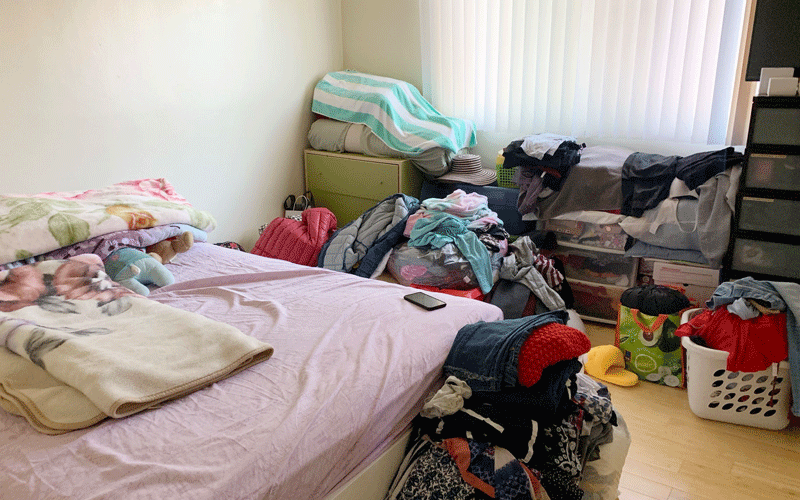Inside a hoarder’s mind…

Media has been replete with Covid-19 stories of people clearing supermarket shelves, stockpiling on tissue paper, sanitisers and food items. Though hoarding is actually a normal and adaptive behaviour that kicks in when there is scarcity, it can also be a medical disorder that causes people to acquire too many possessions and experiencing difficulty getting rid of them when they are no longer useful as BETTY MUINDI finds out.
When Becky Wawira and her husband Lenny Gitonga were still dating, she thought all of the stuff crammed into Lenny’s house belonged to him and his roommate at the time.
When they later got married and moved in together to a one-bedroom apartment, she realised that all of that stuff was his.
Overflowing boxes, stacks of old computer processors, all types of faulty electronics, old clothes and shoes, you name it.
The seemingly endless inventory filled not only every room in their house including their kitchen, but also the entryway outside their house.
Becky’s frustration mounted when months into their marriage, she found herself climbing and stumbling over piles of objects to access things she needed to use.
What was meant to be a bookshelf was filled with old CD players, tech stuff from the days when phones were bricks. And Becky could not get rid of any of them.
“One time, I tried to clear the shelf reminding him that the bookshelf was the place for books and not another receptacle for his mountain of clutter.
He huffed and puffed, stomped out of the house and went mute on me for the rest of the evening,” she says.
For her, decluttering the shelf felt like a small victory in a battle she had been losing for years.
But Becky’s fight for ‘freedom’ is not one to be won soon. Their whole house is a mess, inside their wardrobe are old shirts with torn collars and definitely can never be worn again.
Under their bed is a broken TV, piles of old magazines and books, old travel and gadget receipts, plugs and wires are stacked on the top shelf of the wardrobe.
In the balcony, Becky says Lenny still has an old bicycle covered in rust. He claims he is keeping it for when their son, aged six months is old enough to ride it!
And he says this with his eyes misting over, no doubt sentimentally recalling his teenage adventures in the saddle.
Clutter, third person in marriage
“We argue about his stuff at least once a week. His clutter is the third person in our marriage, to the point that if it was a choice between me or his things, I believe he’d be happier throwing me, rather than his possessions, in a garbage bag,” she laughs in desperation.
Matilda Nyamu, 26 just like Lenny is also a hoarder. “Since I moved out of my parent’s house five years ago, I have a suitcase under my bed that I have never opened.
The suitcase contains piles of old clothes that I will probably never wear again, bags containing goodness knows what, jewellery and even a doll that I owned when I was seven,” she chuckles.
She claims everything is essential—yes, even those sealed motor magazines. She gets furious if someone dares tell her to discard them.
Twelve years down the line, Matilda still has a Bata shoe box, which came with her toughees shoes when she was joining Form One.
She uses the box to keep her little notes as old as her high school days among other paraphernalia.
Hoarding disorder is a persistent difficulty parting with possessions because of a perceived need to save them.
A person with hoarding disorder experiences distresses at the thought of getting rid of the items. Excessive accumulation of items, regardless of actual value, occurs.
Some scientists have classified hoarding as a serious mental health disorder, a type of obsessive-compulsive disorder (OCD) that can lead to dangerous living conditions, malnutrition, and poor personal hygiene.
The hoarding tendency often begins in adolescence and worsens as a person gets older and its cause is unknown.
Lydia Mueni, a counselling psychologist says symptoms of hoarding range from mild to severe.
She says hoarders accumulate possessions, regardless of their value and experience extreme attachment to them, thus severe anxiety when making decisions about whether to keep or discard them.
“These items pile up to the point that they create difficulty using the space for its intended purpose,” she explains.
Coping mechanism
Further studies show hoarding occurs more frequently in men than women.
Clinical psychologist and author of Key To Calm, Linda Blair believes hoarding mainly affects men because women are more socially aware and prefer not to show their anxieties in this way. Anxiety, she believes, is often the cause.
Further, she says possessions are an extension of our identity. “If you are not confident about who you are, that anxiety can take the form of holding on to things,” she explains.
Some people develop hoarding tendencies after experiencing a stressful life event that they had difficulty coping with, such as the death of a loved one, divorce, losing their possessions in a fire, according to The Mayo Clinic, an online American academic medical centre.
A 2013 research professed it to have evolutionary origins, with hoarders having an urge to stockpile resources for times of scarcity.
That could explain why in the wake of the ongoing coronavirus pandemic, many people took to hoarding toilet paper, hand sanitiser and food to soothe their stresses and anxieties.
Mueni says anxiety about finances and resource availability can lead to hoarding behaviour.
“The problem with using hoarding behaviours to cope is that the feelings of situational control and the resulting anxiety relief are temporary, leading individuals into a cycle of even more hoarding behaviours,” she offers.
Mueni’s advise to people who live with hoarders is to first try not to condemn them as this may make them more anxious and hoard more.
“If you can, give them a space that is theirs and theirs alone and let them do all the collecting and hoarding they want in it.
This way you are not only setting clear boundaries, but also allowing them to indulge,” she says in conclusion.















